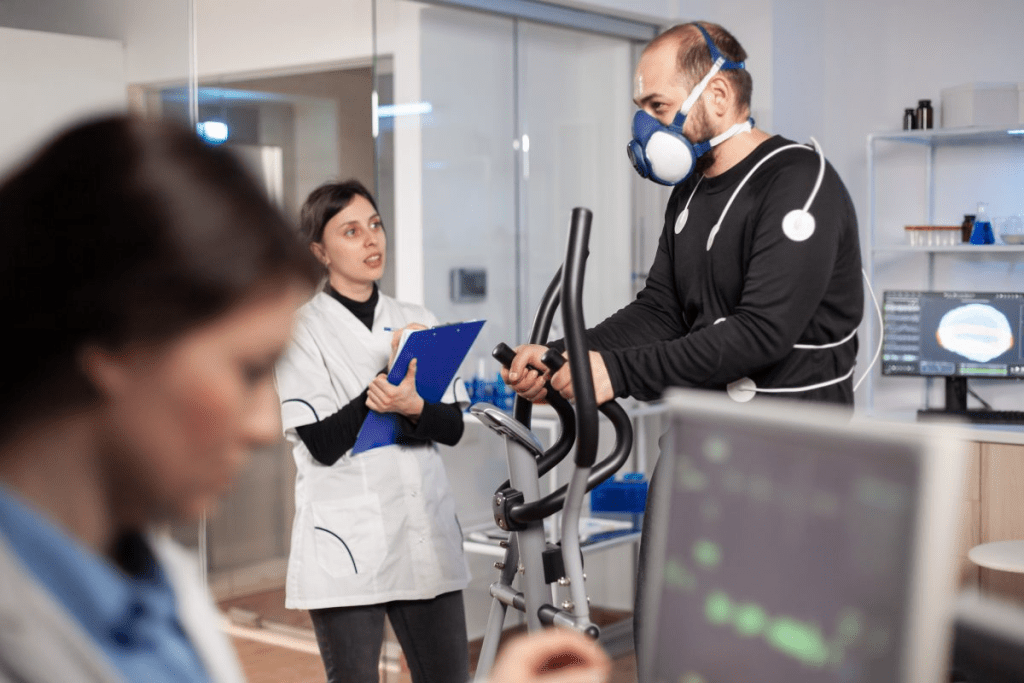Last Updated on October 31, 2025 by

Understanding prostate cancer screening is key for men’s health. Urologists use two main ways to check the prostate. We’ll look at these methods, including a prostate-specific antigen (PSA) blood test and a digital rectal examination (DRE).
The PSA blood test takes a blood sample to measure prostate-specific antigen levels. A DRE involves inserting a lubricated, gloved finger into the rectum to feel the prostate. It’s important to know about these methods and their limits for prostate cancer screening.
Monitoring prostate health is key to men’s health. It helps prevent and manage prostate diseases. We’ll look at why prostate health matters and the conditions that need medical care.
The prostate gland is a small, walnut-sized organ in the male reproductive system. It’s located below the bladder and around the top of the urethra. The prostate gland produces seminal fluid, which helps sperm.

The prostate gland is vital for men’s health. Issues with it can cause erectile dysfunction or infertility. It’s important to check prostate health regularly for early detection and treatment.
Several conditions can affect the prostate, some serious. Here are common ones:
Regular PSA screening and visits to a urologist help detect and manage these conditions early. It’s important for men to know the risks and talk about prostate health with their doctor.
Understanding the importance of prostate health monitoring helps men stay healthy and well.
Men often wonder what to expect during a prostate exam. It’s a thorough check of prostate health. Knowing what to expect can help ease worries. So, let’s go through the steps, from the first talk to the physical exam parts.
Your prostate health check starts with a consultation with a urologist. Here, you’ll talk about your health history and any symptoms. You’ll also share your worries about prostate health. This first talk is key to the exam process.
It’s good to be ready to talk about your family’s health history. Some conditions can raise your risk for prostate problems. Your urologist will also ask about symptoms like trouble urinating or pain.
The physical exam is a big part of checking your prostate. It usually includes a digital rectal examination (DRE). A healthcare pro will put a gloved, lubricated finger in your rectum to feel your prostate.
Here are the main parts of the physical exam:
In the DRE, the doctor looks for any odd lumps or hardness in the prostate. This check is key to finding any problems that need further looking into.

Many men feel apprehensive about the Digital Rectal Examination. But knowing what it involves can help ease worries. We’re here to walk you through this important test.
The Digital Rectal Examination is a simple yet key procedure. Here’s what you can expect:
During the DRE, we look for any unusual signs in the prostate gland. This includes lumps, hard spots, or any changes in size or shape. These could point to prostate cancer or other issues like prostatitis or BPH.
The main goal is to spot any problems early, so we can act quickly.
Even though the DRE is helpful, it has its limits. It can miss some cancers, with a sensitivity rate of 51%. This is because it can’t find all cancers, or those in hard-to-reach areas.
It’s key to remember that the DRE is just one part of checking prostate health. We often use it with other tests, like the PSA blood test, to get a full view of your prostate health.
Men should know about the PSA blood test for prostate cancer screening. This test checks the prostate-specific antigen in your blood. It can show if you have prostate cancer, but it’s not always accurate.
The PSA test is a simple blood test. It looks for a protein made by the prostate gland. If you have too much of this protein, it might mean you have prostate problems, like cancer.
When you get your PSA results, think about your age, health, and medical history. A PSA level under 4 ng/mL is usually okay. But a high PSA doesn’t always mean you have cancer.
Here are some key points to consider when interpreting PSA results:
The PSA test is common in prostate cancer screenings. Many men get tested as part of their health check-ups. About 78% of men aged 55-69 have had a PSA test.
Talking to your doctor about PSA testing is important. This helps you understand its role in your prostate health.
Knowing what to expect during your prostate exam can help you feel less anxious. We’ll walk you through the process, making sure you’re in the loop every step of the way.
Getting ready for your prostate exam is key. Share any worries or questions with your urologist. Also, tell them about any medicines you’re taking.
Being well-informed and ready can ease your worries and make the exam go smoothly.
Your urologist will do several tests to check your prostate. This might include a Digital Rectal Examination (DRE) and a Prostate-Specific Antigen (PSA) blood test.
After the exam, your urologist will talk about the results. They’ll tell you if more tests are needed and what to do next.
Being informed and proactive helps you manage your prostate health. This way, you can make smart choices about your care.
Prostate evaluation has seen a big leap forward with new diagnostic methods. These modern tools have made diagnosing prostate cancer more accurate. We’ll look at MRI-guided diagnostics, ultrasound, and biopsy procedures.
MRI-guided diagnostics are a powerful tool in prostate evaluation. They use Magnetic Resonance Imaging (MRI) to spot suspicious areas in the prostate. This helps doctors target biopsies better and see how much cancer there is.
The benefits of MRI-guided diagnostics include:
Ultrasound is key in advanced prostate evaluation. Transrectal ultrasound (TRUS) helps guide biopsies and check prostate size. New ultrasound tech has made images clearer, leading to more precise checks.
Some key aspects of ultrasound techniques include:
Biopsy procedures are vital for prostate cancer diagnosis. If tests show suspicious areas or high PSA levels, a biopsy might be needed. MRI and ultrasound help guide the biopsy needle for better samples.
It’s important to know that:
In conclusion, new diagnostic methods have greatly improved prostate health evaluation. MRI-guided diagnostics, ultrasound, and precise biopsies help diagnose and treat prostate cancer better.
Deciding on prostate cancer screening is a personal choice. It’s best to talk about it with a healthcare provider. They can help weigh the pros and cons based on your risk factors.
When to start prostate cancer screening depends on several factors. Generally, men should discuss it at 50. But those with a family history or other risks might need to talk about it earlier.
The American Cancer Society suggests starting discussions at 40 to 45 for high-risk groups. This includes African Americans and those with a family history of prostate cancer before age 65.
Some men need to start screening earlier or more often. This includes those with a family history of prostate cancer, being African American, or having genetic mutations like BRCA1 or BRCA2.
It’s important to know these risk factors. If you have them, talk to your doctor about screening. They can help weigh the benefits and risks for you.
Choosing to screen for prostate cancer involves weighing its benefits and harms. Benefits include early detection and treatment, which can improve outcomes. But there are risks like false positives and unnecessary biopsies.
Discussing these points with your doctor is key. This way, you can make a decision that fits your health and values.
Shared decision-making is a team effort. It’s about talking through your risk factors, the screening’s benefits and risks, and what matters most to you.
This approach makes sure the screening decision is right for you. It considers your unique situation and needs.
Learning about prostate checks and health monitoring lets people take care of themselves. Knowing about prostate health can make men feel less worried. This way, they can be more active in looking after their health.
Spotting prostate cancer early and treating it can greatly help men. Being informed about prostate cancer tests helps people make smart health choices. We stress the need for regular check-ups and screenings to keep the prostate healthy.
Being proactive about prostate health is key to overall well-being. We urge people to talk to a urologist to find out what’s best for them. This can help lower the risk of prostate problems and improve health outcomes.
A prostate exam checks the prostate gland’s health. It helps find prostate cancer and other issues early. This makes treatment more effective.
A urologist looks for prostate problems during an exam. They use a Digital Rectal Examination (DRE) and a Prostate-Specific Antigen (PSA) blood test. These help find any issues.
A DRE is a quick exam where a healthcare provider checks the prostate through the rectum. It’s done with a gloved, lubricated finger. It’s painless and fast.
A DRE can spot some prostate problems, but not all. It has a 51% sensitivity rate. This means some issues might not be found.
A PSA test checks the blood for Prostate-Specific Antigen levels. High levels might mean cancer or other issues. It’s a key part of routine screenings.
To get ready for a prostate exam, avoid certain meds or supplements. Talk about your health and any symptoms with your doctor.
Screening can find cancer early, making treatment easier. But it can also lead to false positives and overdiagnosis. Always talk to your doctor about the risks and benefits.
Advanced methods include MRI-guided diagnostics, ultrasound, and biopsies. They give detailed info about the prostate. This helps diagnose cancer and other conditions.
Screening guidelines depend on age, risk factors, and more. Men aged 55 to 69 should talk to their doctor about screening. It’s about weighing the benefits and risks.
Being apprehensive means feeling nervous or uneasy about the exam. Knowing what to expect can help ease these feelings.
To manage your prostate health, learn about screening. Understand the risks and benefits. Talk to your doctor about your specific situation.
Subscribe to our e-newsletter to stay informed about the latest innovations in the world of health and exclusive offers!